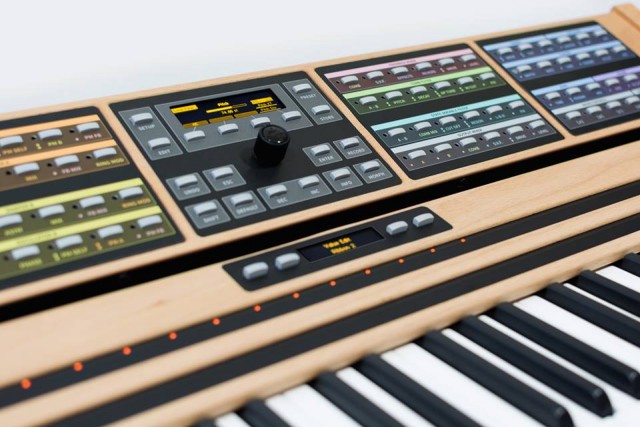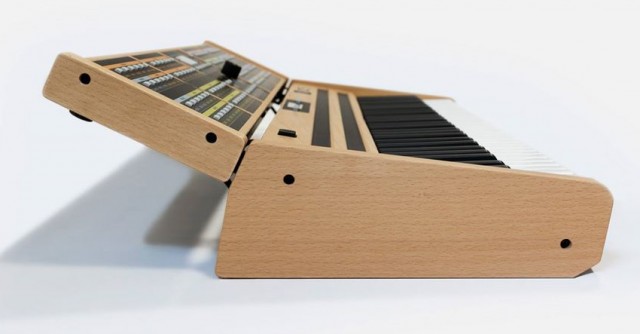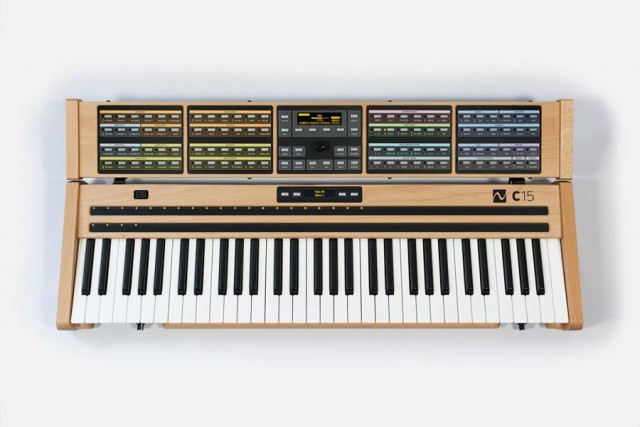Nonlinear Labs has shared some new teaser photos of their upcoming C15 (aka Emphase) synthesizer:
Nonlinear Labs C15 concepts:
- Standalone systems. Self-contained synths, based on Linux systems & ARM processors. Optionally, software GUIs can be used by connecting external devices via Wi-Fi.
- Full control. They have developed the TCD musical control protocol which they say overcomes many limitations of MIDI. TCD stands for “Time, Curve, Destination” and implements a high-resolution control over all aspects of a dynamic and expressive live musical performance.
- Software-based digital sound synthesis. “Software-based” means that the durable instruments can evolve without falling into obsolescence.
- Top-quality hardware
- Open source
- Local production. Prototyping and production is carried out as locally as possible.
Features:
- 61-key Fatar keybed with semi-weighted long-arm keys; two-way (note-on and note-off) velocity sensitivity; global aftertouch
- Two high-resolution touch strips (ribbons). They can be assigned to pitchbend, macro controls, or single parameters and offer both relative and absolute modes.
- Indicator bar of LED dots in each ribbon
- Spring-loaded lever (not in current version) for pitchbending and similar applications
- Small control panel with an OLED display (128 x 32). In connection with the ribbons it can be used for:
- preset selection
- octave shift up/down, note shift, tuning
- assigning ribbons, lever, and pedals
- preferences: velocity curves, ribbon modes, etc.
- selecting and editing parameters
- headphone jack and level knob
- master volume knob
- audio outputs
- four inputs for analog controls, such as pedals
- USB connector for updates and service (not in current version)
- The modular design is open for variable user interface concepts. The current configuration:
- Four Selection Panels, each with 24 buttons with corresponding state-indicating LEDs. The software-defined functions of the buttons are indicated by interchangeable magnetic foils.
- Edit Panel with 18 buttons, an incremental encoder, and a 256 x 64 OLED display
- Functions:
- Parameter editing:
- selecting parameters
- displaying labels and values of parameters
- changing value
- Presets:
- browsing, selecting and recalling presets
- storing the current edit buffer as new preset
- overwriting, deleting, moving and sorting of presets
- Morphing:
- between two presets
- between the current state and a preset
- Unlimited Undo for all sound editing interactions
Here’s a video preview of the user interface:
Nonlinear Labs has also shared some information on the Empase sound engine, saying that it will build on work on they did for NI”s Kontour.
Official details and audio demos of the C15 are to come. See the company’s site for more info.








Did anyone else misread that heading to “highly expensive” and think they got it right anyway?
YES. Immediately.
My wallet’s butt hole cringed at the sight of it.
One knob, SRSLY?
I think the hundreds of buttons and one knob approach is a pretty smart trade-off. You give up menu diving and have near instant access to all parameters. You can even use the ribbon on all params which is a nice touch.
There might be ways to control multiple params with the touch device. There might be ways to use a knob box to control it as well.
One knob is smart, and does have advantages, but it drives me nuts not to see how things are set.
“One knob?”
Look again, it also has two performance knobs on the front of the instrument, below the keyboard.
There’s also a pitch lever.
also four inputs for floor pedals/expression pedals.
Saw the knobs on the front and thought ‘they’ll get knocked off at a gig first’
I’m not sure that anybody wants to spend a wad of cash on a new synth just to find themselves sitting in front of it using an iPad as the user interface..
One knob, a thousand buttons. You push a button and the knob controls that parameter.
may as well use plugins and a midi controller if you have to do that. not being able to grab two different controls at the same time puts me straight off
yeah, just release as a module brain maybe and optional keyboard? tons of controllers will bring better expression than this package. novation SL Mk2’s stick and XY pad and faders will trump a simple fatar anyday
Just like they did it on the Moog Source … I’ll always have a soft spot in my heart for that rectangular slab of synth goodness.
“Software-based means that the durable instruments can evolve without falling into obsolescence.”
interesting, usually software based means exactly the opposite…
Did anyone else think it said CS-15? As in a Yamaha CS-15 remake?
Frankly, that would have been better news.
That would be amazing news and a great step forward on the path to redeption for Yamaha
I also thought it said highly EXPENSIVE. But reading more about it, it could be in the Modulus range.
Also, ONE KNOB?!?!?!?!? Most people are used to the “moog layout” and most people expect knobs for things like cutoff, resonance, oscilator type… I think that this would be truly sexy if they alternated between groups of buttons, knobs, encoders, etc. So that way you can decide what to do with what. Maybe a group of knobs will be filter, maybe buttons for oscilators, maybe encoders for continously variable parameters. OR it could be great if you could just manually change a button for a knob.
Isn’t modulus the definition product for expensive!? The modulus.002 is over $5000?!
One knob worked well for Synclavier…oh, wait…
finally a company that incorporates all the design errors of synths from the 80s and 90s!
What’s the point of hardware control without the flipping control!?!?
I get what they’re going for but I don’t see many people owning one. It certainly looks nice aesthetically but come on man, this generation wants knobs and faders, not 100 buttons with one freaking knob!!
seriously I can turn like ten knobs at once so give me at least that many
I’ll take the keyboard with the two ribbons, thats exactly what I want, ditch everything else. 500 notes
A lot of people will have a problem with the interface and I can understand if knobs are your background. I personally think the adaptability of the control panel will be a really nice thing. This video focused on the external factors, but I’m really interested to hear what hardware they use for the digital engine. It really needs to be a rocket under the hood for this to truly make sense.
If my poly-61 taught me anything it’s that buttons mean STABBY STABBY ANGER STABBY especially as they buttons perform more poorly over time (yes the STABBY STABBY may have contributed) all a knob ever needs is a bit of graphite.
Snap goes that panel at the back 🙁
Props to them for making something a bit different tho
at least the color makes it unique
This seems to be a terrible idea with even worse implementation. Ostensibly, you have replaced knobs per function (good) and menu diving (bad) with button search with a single knob (perplexing). on top of which, as the promotional video suggests, a deeply editable synthesizer will require an ancillary device such as an ipad to access the deeper engine.
? It would seem appropriate that such a “deep” and complex synth have dedicated controls and knobs for immediacy in editing and sound creation. This is critical as one knob will not allow you to see the interrelationship of multiple parameters being edited and how that visually may affect the sound.
? When this was initially introduced some three years ago, they used the word “uncompromising” in every other sentence. Yet the first notion I had when looking at the interface was…”compromising” functionality and usability.
? It is still amazing to me that synth makers in this price range would expect an iPad screen to be used as a complimentary piece…when they could have easily incorporated a screen into the device for as little as $110 to $150 per unit. This price would reflect the graphic controller chip as well as touch capability.
? Stephan is no novice, yet this is a very disappointing approach from the onset.
the Hartmann Neuron approach might’ve been applicable here: 4 configurable joysticks to have your favourite params ready for modulation at any time. Even four faders or knobs, but 1 knob, yeah no
If it does’nt come with mini-keys, I’m not interested..
and fits in a purse?
It’s interesting to see all the criticism of not having one-knob-per-function, but if you think about it this has one-button-per-function, so no menu diving. It’s true you will have to press the use the knob, and you can’t use two at once, but that’s pretty much the only limitation. It’s still much better than any menu system or mouse and keyboard.
I guess it’s not the perfect synth for knob twisters, but then you’re paying for a large, quality keyboard, so presumably you’re mostly going to be using your hands for that. It seems to me that this is perfect for one end of the synth market – keyboard players; with the other end – knob twisters – being well served by Eurorack. That seems like a good way to divide up the market and allow for more specialised instruments.
Yes no menu diving, but you always needs 2 steps (a button then the knob) to tweak anything while one-knob-per-function requires only 1 step. This is a huge, incredibly huge difference in terms of efficiency if you’ve ever done complex synth programming.
That is a great point Jimmie, my thoughts precisely. Moreover, it is a missed opportunity. To those that think this is somehow off the beaten path, hardly. It is the 80’s and 90’s revisited. Albeit I am certain it is improved, yet hardly a revolutionary thinking.
We’ll do it right, 2017.
Not to mention the distance between the knob and the button. If one is using only one hand, that can be a lot of distance to tweak a parameter.
Would have been better suited to at least a know for each section
these news are so 2014…
http://www.musicradar.com/news/tech/native-instruments-founder-shows-emphase-hardware-synth-prototype-594390
Tobi – if you look at that Music Radar post, they credit it as ‘via Synthtopia’ and link to our post on an earlier prototype of this synth, the ‘Emphase’:
https://www.synthtopia.com/content/2014/02/12/the-emphase-synthesizer-sneak-preview-looks-beyond-midi/
As noted in the post, Nonlinear has shared new preview images of their ‘C15’ synth.
There’s so much negativity here, it’s pathetic. I think it’s great that these people are making something new and different, and especially since it isn’t another re release of some retro vintage analog synth aimed at following a trend.
I don’t know, perhaps the button matrix interface isn’t as bad some people imagine. The typical human can only manipulate two knobs at a time. This synth has a knob on the front panel, two just below the keyboard, and two touch strips (which I imagine will allow for much quicker and broader parameter sweeps), and most likely the ability to add an external control surface, if you wish. How many parameters are you normally adjusting at a single given moment?
I’m thrilled that this is not a retro rerelease or some analogue recreation. Yet I’m aghast at the seemingly 80’s UI.
“typical human can only manipulate two knobs at a time”
isn’t it true : )
This is a real 90s-style facepalm interface. They could at least put a bank of 8 knobs that change depending on the button pressed.
Refreshing to see someone taking such an offbeat approach. There can be no progress without experimentation and deviation from the “stick with what works” mindset.
I think it’s a good idea. Although I personally prefer hardware synths, this could be a good controller for software-based sounds. The ribbons make sense as well. And the magnetic overlays, well, it’s cheaper than LCD displays. I think it’s a good idea.
Well, I’ve gotten this far in life with one knob. I’d give this synth a shot.
i do not need to look past the one knob…this is not for me. i am feel most comfortable with on knob one function. but thats just me.
If this thing is over a grand I can’t imagine why really anyone would put up over that interface over a midi controller and VST. These days digital hardware synths really need to offer more in regards to hands on twekaking to compete with VSTs. Even the Pulse and Blofeld’s multiple knob based matrix editing would probabaly be faster and would have been a betteridea than this. Can you imagine how tedious programming a adsr envelope on this thing would be?
This is an appallingly bad design. Maybe there are people out there who really think this way, but 100 buttons and one knob is the opposite philosophy that I want to work with in an instrument. This looks absolutely nightmarish.
All of those saying this synth is not for them are absolutely right. It isn’t!
This is something different, as the designers and developers intended. The EDM crowd and all the bi-dexterous knob twisters will be disappointed but it was made for somebody else. Who?
Best to wait until it is released to say who might find its particular forms of expressiveness useful and hope its expressiveness is proportionate to its expensiveness.
maybe the TCD engine is a slightly different approach and hence adjusting multiple knobs in the usual fashion is not required/desired.
I prefer one knob one per function in general, but still hopeful to see how the interface works with the engine. Need to check out Kontour too.
My Kawai K3 has 57 buttons and one knob and I rather like it.
I just had the pleasure to test a prototype of Nonlinear Labs’ C15 for one week, so I take the liberty to resurrect this thread… in case anyone’s interested? 😉